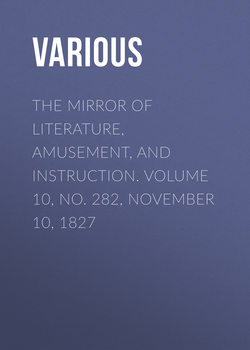Читать книгу The Mirror of Literature, Amusement, and Instruction. Volume 10, No. 282, November 10, 1827 - Various - Страница 5
Architectural Illustrations
CUSTOM OF BAKING SOUR CAKES
Оглавление(For the Mirror.)
Rutherglen, in the county of Lanarkshire, has long been famous for the singular custom of baking what are called sour cakes. About eight or ten days before St. Luke's fair (for they are baked at no other time in the year), a certain quantity of oatmeal is made into dough with warm water, and laid up in a vessel to ferment. Being brought to a proper degree of fermentation and consistency, it is rolled up into balls proportionable to the intended largeness of the cakes. With the dough is commonly mixed a small quantity of sugar, and a little aniseed or cinnamon. The baking is executed by women only; and they seldom begin their work till after sunset, and a night or two before the fair. A large space of the house, chosen for the purpose, is marked out by a line drawn upon it. The area within is considered as consecrated ground, and is not, by any of the bystanders, to be touched with impunity. The transgression incurs a small fine, which is always laid out in drink for the use of the company. This hallowed spot, is occupied by six or eight women, all of whom, except the toaster, seat themselves on the ground, in a circular form, having their feet turned towards the fire. Each of them is provided with a bakeboard about two feet square, which they hold on their knees. The woman who toasts the cakes, which is done on an iron plate suspended over the fire, is called the queen, or bride, and the rest are called her maidens. These are distinguished from one another by names given them for the occasion. She who sits next the fire, towards the east, is called the todler; her companion on the left hand is called the trodler;15 and the rest have arbitrary names given them by the bride, as Mrs. Baker, best and worst maids, &c. The operation is begun by the todler, who takes a ball of the dough, forms it into a cake, and then casts it on the bakeboard of the trodler, who beats it out a little thinner. This being done, she, in her turn, throws it on the board of her neighbour; and thus it goes round, from east to west, in the direction of the course of the sun, until it comes to the toaster, by which time it is as thin and smooth as a sheet of paper. The first cake that is cast on the girdle is usually named as a gift to some man who is known to have suffered from the infidelity of his wife, from a superstitious notion, that thereby the rest will be preserved from mischance. Sometimes the cake is so thin, as to be carried by the current of the air up into the chimney. As the baking is wholly performed by the hand, a great deal of noise is the consequence. The beats, however, are not irregular, nor destitute of an agreeable harmony, especially when they are accompanied with vocal music, which is frequently the case. Great dexterity is necessary, not only to beat out the cakes with no other instrument than the hand, so that no part of them shall be thicker than another, but especially to cast them from one board to another without ruffling or breaking them. The toasting requires considerable skill; for which reason the most experienced person in the company is chosen for that part of the work. One cake is sent round in quick succession to another, so that none of the company is suffered to be idle. The whole is a scene of activity, mirth, and diversion. As there is no account, even by tradition itself, concerning the origin of this custom, it must be very ancient. The bread thus baked was, doubtless, never intended for common use. It is not easy to conceive how mankind, especially in a rude age, would strictly observe so many ceremonies, and be at so great pains in making a cake, which, when folded together, makes but a scanty mouthful.16 Besides, it is always given away in presents to strangers who frequent the fair. The custom seems to have been originally derived from paganism, and to contain not a few of the sacred rites peculiar to that impure religion; as the leavened dough, and the mixing it with sugar and spices, the consecrated ground, &c.; but the particular deity, for whose honour these cakes were at first made, is not, perhaps, easy to determine. Probably it was no other than the one known in Scripture (Jer. 7 ch. 18 v.) by the name of the Queen of Heaven, and to whom cakes were likewise kneaded by women.
J. S. W.
15
These names are descriptive of the manner in which the women, so called, perform their part of the work, To todle, is to walk or move slowly, like a child; to trodle, is to walk or move more quickly.
16
From our Correspondent's description of these cakes, we suppose them to resemble the wafers sold by the confectioners, except in the elegant designs on their surface.
